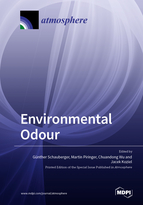Environmental Odour
A special issue of Atmosphere (ISSN 2073-4433). This special issue belongs to the section "Air Quality".
Deadline for manuscript submissions: closed (31 May 2021) | Viewed by 40566
Special Issue Editors
Interests: annoyance assessment; odour emission; determination of odour exposure
Special Issues, Collections and Topics in MDPI journals
Interests: odour dispersion; environmental pollution; boundary-layer meteorology; urban meteorology
Special Issues, Collections and Topics in MDPI journals
Interests: Odors; VOCs; Olfactometry; Gas Chromatography–Mass Spectrometry; Air Quality; Sensory Analysis
Interests: greenhouse gases; mitigation of gaseous emissions; nutrient management; livestock production systems; sustainable agriculture
Special Issues, Collections and Topics in MDPI journals
Special Issue Information
Dear Colleagues,
Environmental odor is perceived as a major nuisance by the rural as well as the urban population. The sources of odorous substances are manifold. In urban areas, these include restaurants, small manufacturing trades, and other sources, which might cause complaints. In the suburbs, wastewater treatment plants, landfill sites, and other infrastructures are the expected major odor sources. These problems are often caused be the accelerated growth of cities. In rural sites, livestock farming and the spreading of manure on the fields is blamed for severe odor annoyance. In fact, environmental odors are considered to be a common cause of public complaints by resident to local authorities, regional, or national environmental agencies. This Special Issue of Atmosphere will treat the entire chain from the quantification of odor sources, abatement methods, the dilution in the atmosphere, and the assessment of odor exposure for the assessment of annoyance. In particular, this Special Issue aims to encourage contributions dealing with field trials and dispersion modeling to assess the degree of annoyance and the quantitative success of abatement measures.
Prof. Dr. Günther Schauberger
Dr. Martin Piringer
Dr. Chuandong Wu
Prof. Dr. Jacek Koziel
Guest Editors
Manuscript Submission Information
Manuscripts should be submitted online at www.mdpi.com by registering and logging in to this website. Once you are registered, click here to go to the submission form. Manuscripts can be submitted until the deadline. All submissions that pass pre-check are peer-reviewed. Accepted papers will be published continuously in the journal (as soon as accepted) and will be listed together on the special issue website. Research articles, review articles as well as short communications are invited. For planned papers, a title and short abstract (about 100 words) can be sent to the Editorial Office for announcement on this website.
Submitted manuscripts should not have been published previously, nor be under consideration for publication elsewhere (except conference proceedings papers). All manuscripts are thoroughly refereed through a single-blind peer-review process. A guide for authors and other relevant information for submission of manuscripts is available on the Instructions for Authors page. Atmosphere is an international peer-reviewed open access monthly journal published by MDPI.
Please visit the Instructions for Authors page before submitting a manuscript. The Article Processing Charge (APC) for publication in this open access journal is 2400 CHF (Swiss Francs). Submitted papers should be well formatted and use good English. Authors may use MDPI's English editing service prior to publication or during author revisions.
Keywords
- odor
- emission
- dilution
- atmospheric dispersion
- ambient odor concentration
- annoyance
- separation distance









